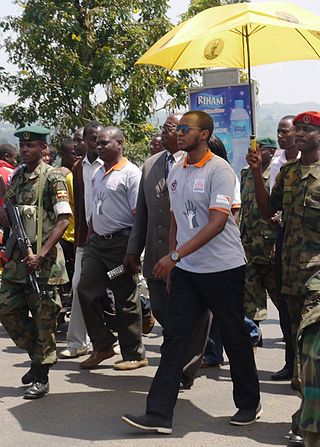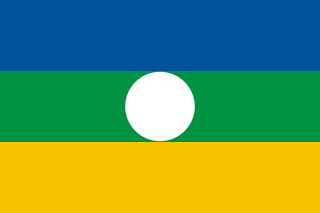
Kasese District is a district in Western Uganda. Like most other Ugandan districts, the town of Kasese is the site of the district headquarters.

Kasese is a town in the Western Region of Uganda. It is the capital of Kasese District. Kasese is also the largest town in the Rwenzururu region. In 2020 it had an estimated population 115,400. It lies north of Lake George and east of Rwenzori Mountains.

Rukirabasaija Omukama Oyo Nyimba Kabamba Iguru Rukidi IV, King Oyo, is the reigning Omukama of Tooro, in Uganda. He was born on 16 April 1992 to King Patrick David Mathew Kaboyo Olimi III and Queen Best Kemigisa Kaboyo. Three and half years later in 1995, Oyo ascended the throne and succeeded his father to become the 12th ruler of the 180-year-old Kingdom of Tooro.
Amon Bazira was a Pan-Africanist leader and organiser who created an extensive intelligence network that was a clandestine component of the struggle to end the regime of Ugandan military dictator and president, Idi Amin. After helping to remove Idi Amin, Bazira served as Deputy Director of intelligence, and then as Director of Intelligence in Uganda in 1979. He produced a government report predicting that there would be a massive genocide in Rwanda that would lead to the collapse of order in Central and Eastern Africa, and proposed granting citizenship to Rwandan refugees and other displaced Africans in Uganda, as a means of preventing genocidal warfare. In August 1993, Amon Bazira was assassinated in between Nairobi and Nakuru in Kenya.

Crispus Walter Kiyonga, whose first name is sometimes spelled Chrispus, is a Ugandan physician, politician and diplomat, who serves as Uganda's Ambassador to China, based in Beijing. He previously served as the Minister of Defence in the Cabinet of Uganda from 2006 to 2016.
The National Army for the Liberation of Uganda was a rebel group opposed to the Ugandan government. It was formed in 1988 in western Uganda and moved into eastern Democratic Republic of the Congo, where it merged with the Allied Democratic Forces (ADF), another Ugandan rebel group.
The Konjo, BaKonzo, or Konzo, are a Bantu ethnic group located in the Rwenzori region of Southwest Uganda in districts that include; Kasese, Bundibugyo, Bunyangabu and Ntoroko districts.
Amba is a Bantu ethnic group located on the border area between the DRC and Uganda south of Lake Albert in the northern foothills of the Rwenzori Mountains. On the Uganda side, they are found in Bundibugyo District. On the Congolese side, they are located in the Watalinga and Bawisa subcounties of Beni, South Kivu. Numbering 42,559 on the Uganda side in the 2014 census and 4,500 on the Congolese side according to a 1991 SIL International estimate, Ethnologue lists their total population as 40,100. Agriculturalists, the Baamba traditionally cultivate plantains, millet, maize, sweet potatoes, peanuts, rice, coffee, cotton, and cassava, while raising goats and sheep. The Baamba practice Christianity.
Charles Wesley Mumbere,(born in 1952) known by his royal title Irema-Ngoma I, is the king of the African kingdom of Rwenzururu, a subnational kingdom within Uganda. Mumbere was arrested in December 2016 after the clashes in the kingdom's capital of Kasese, and has since been in prison awaiting trial.

Toro sub-region is a region in Uganda that is coterminous with Toro Kingdom in Western Uganda. The districts that constitute the sub-region include the following:
The Songora or Shongora also known as "Bacwezi", "Chwezi", Huma or "Bahuma") are a traditionally pastoralist people of the Great Lakes region of Central Africa
Mubuku is a settlement in Uganda.
Yenga is an Amba village in western Uganda, Bundibugyo District, on the border with the Congo. It lies in the rift valley between Lake Albert and Lake Edward above the Semliki River. The village is within the borders of the Semuliki National Park. To the south of the village are the foothills of the Rwenzori Mountains. While Yenga is only 24 kilometres (15 mi) from the district capital of Bundibugyo, the nearest town of substance is Fort Portal. Yenga is located in lowland tropical rainforest, much like the Ituri Rainforest across the river.

Violence erupted on 26 November 2016 in the town of Kasese, the capital of the Ugandan Kingdom of Rwenzururu, when Ugandan police raided the government offices of the Rwenzururu kingdom, killing eight Rwenzururian royal guards and arresting two others. According to the government of Uganda, the raid was in response to militant attacks on police posts in the region two weeks earlier, allegedly perpetrated by the royal guards.

The Rwenzururu movement was an armed secessionist movement active in southwest Uganda, in the subnational kingdom of Tooro. The group was made up of Konjo and Amba fighters and was led by Isaya Mukirania. It disbanded in 1982 following successful peace negotiations with the Ugandan government.
Isaya Mukirania, known by his royal title Kibanzanga I, was the leader of the Rwenzururu movement and the first Omusinga (king) of the Kingdom of Rwenzururu on 30 June 1963. He was formally succeeded by his son Charles Mumbere over 43 years after his death, on 19 October 2009.
The Omusinga wa Rwenzururu is the royal title given to the monarchs of the Kingdom of Rwenzururu. The title was technically held by Charles Mumbere for over 43 years after the first Omusinga, his father Isaya Mukirania, died in 1966. However, Mumbere was not formally crowned and recognised by the Ugandan government until 2009.
The Prime minister of Rwenzururu, known locally as the omulerembera, is the highest administrative post within the government of the Kingdom of Rwenzururu in Uganda. The appointment is the prerogative of the monarch.
Florence Kabugho is a Ugandan politician and former radio journalist, elected to the eleventh Parliament of Uganda in the 2021 general election, as the woman representative for Kasese District.
Kambale Ferigo is a Ugandan politician and legislator, representing Kasese municipality in the 11th Parliament of Uganda.









